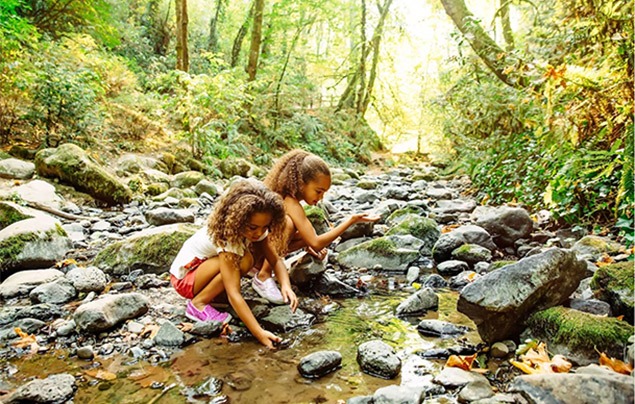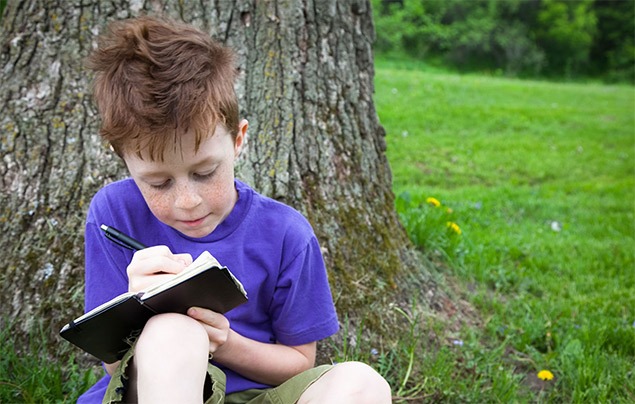20 ways to bring out the explorer in your kid
Discover fun activities that will inspire curiosity and bolster your young adventurers’ self-confidence.
Whether your children are more into Amelia Earhart or Luke Skywalker, they can learn important life skills from explorers.
Observation, creativity, self-confidence and curiosity are traits that all adventurers share. And being outside in nature – whether it’s as a daily boredom buster or part of a family holiday – is a great way to foster these qualities for life.
Here are 20 ideas to nurture your kid’s natural explorer…
Enhance observation
1. Be tree detectives.
Have them observe and collect visual clues like leaf shape and size, bark colour and texture, and whether the tree has flowers or cones. Then let kids solve the mystery of what kind of tree it is, using an old-school tree field guide.
2. Create a neighbourhood map.
Roll out a big piece of paper so kids can draw in the trees, houses, gardens and other landmarks they observe on their expeditions (i.e., neighbourhood walks). Mapmaking requires attention to detail and encourages kids to focus on what’s around them.
3. Play nature bingo.
Print out 25-space bingo cards to carry on hikes or walks. Pre-fill the blocks with natural things to look for like a spiderweb, jagged rock and local birds. Then get spotting!
4. Choose a sit-spot.
Pencil in a daily ‘sit-spot time,’ – a favourite practice among naturalists. Kids pick an outdoor site to sit, unplug and tune in to nature for 20 minutes each day. Calm fidgety fingers with a notebook to write or draw observations. Combine this activity with a spot of forest-bathing, if you’ve a wood nearby.
5. Focus on creature features.
Whether it’s a squirrel’s busy tail or a rabbit’s oversized feet, animals have signature physical characteristics that usually serve a purpose (like, yikes, let me hop away from that predator really quickly!). Researching why critters look and act the way they do gives kids more incentive to quietly observe wildlife while being outside.
Looking for even more brilliant ideas? Sign up to the free National Geographic Kids newsletter for kid-friendly activities, good news and family day out ideas, straight to your inbox.
Ignite curiosity
6. Design a wildlife friendly garden.
Who knows what will show up when you create a space where birds, butterflies and other creatures feel at home? Put kids in charge of choosing food sources (like feeders or seeds from native plants) and flora that provide safe places for hiding from predators and raising their young. (Here are some family-friendly top tips to start feeding the birds.)
7. Point and click.
One tap of the Seek app by iNaturalist gives kids (under your supervision) the power to identify plants and wildlife they’re curious about. Using a camera, image recognition technology and lists of commonly seen wild things in your area, the app clues in curious explorers about what they’ve discovered. Plus, families and kids 13 and older can earn badges by sharing observations online.
8. Watch plants drink.
Kids are always curious about how things work – and that includes plants. Stems are basically plant straws, so to see how they suck water from the soil, try this simple experiment. Add water and red food colouring to a glass jar, stick the stem end of a white carnation or daisy inside, and watch the thirsty flowers slowly turn pink from their drink.
9. Take a literary field trip.
Broaden your kids’ horizons without ever leaving home, with a subscription to National Geographic Kids magazine. Each issue is packed with fascinating features, inspiring interviews and amazing photography – giving kids the chance to see, read about and learn from real explorers around the world.
10. Zoom in.
Off-limit areas like treetops and beehives can instil some not-so-acceptable behaviours in children who love being outside. So, focus that curiosity with lower-magnification binoculars (which are easier to hold and provide a wider field of view) to get a closer look at the nature kids can’t or shouldn’t touch. Look for a pair with 8x magnification to make safer-at-a-distance nature appear eight times closer than with the naked eye. Or make your own magnifier to see insect life up-close!
Boost self-confidence
11. Take a night hike.
When the sun powers down, nature’s spooky-cool night crew revs up. On an after-dark family walk, tread lightly, listen closely and work together to identify sounds like owl calls and frog croaks. Wear headtorches to boost the adventure level (and stay safe) and encourage your kids to relish being outside when most other people aren’t.
12. Walk the line.
Elevate your kid’s view of nature – and their sense of what they can accomplish – by suspending a low-hanging slackline between two trees or other fixed objects. Walking a slackline requires balance and focus; falling off (a lot) and trying again builds the resilience kids need to step outside their comfort zones.
13. Follow their lead.
Explorers regularly face setbacks. The next time a downed tree blocks a hiking path, or a sudden closure shuts down an activity, ask the kids for suggestions. Obviously you’ll make the final call, but encouraging kids to weigh in and share their reasoning helps them feel valued and capable.
14. Go west!
Or north, south or east, by teaching kids how to use a compass. The mnemonic “Never Eat Soggy Waffles” helps kids remember how the cardinal directions appear on the compass face. Take turns walking north to south using only the compass needle as a guide to help them feel confident that they’ll always know where they’re going. (Hint: The needle’s red end always points north!)
15. Try something new while being outside.
Stand-up paddle boarding, caving or even just handing over the hiking map opens up children to new experiences that make them feel adventurous and confident. Just for kicks and giggles, take a deep breath and see what new, possibly-scary activity your kid wants to tackle next!
Encourage creativity
16. Create a local biodiversity guide.
If an interplanetary traveller came for a visit, what living things would your kids want it to see? Make local animals and plants the focus and let kids use digital or old-school tools to document their recommendations.
17. Create a Small Stuff photo exhibit.
Inspire creativity by inviting kids to photograph the little parts of nature, not the obvious whole (like a square of gnarly bark instead of the entire tree.) Print and display the photos in a hallway gallery and host an ‘opening’ where budding photographers can talk about their work. (Check out these kid-friendly tips for taking photos like a Nat Geo pro.)
18. Take a micro hike.
A ruler, magnifying glass and creativity are the only tools kids need to shrink down to ant-size hikers. Using the ruler to mark the route, and their imaginations to pretend they’re miniature, kids lie down and ‘hike’ (slowly on their tiny ant legs), using the magnifier to make discoveries.
19. If trees could talk…
What would they say after standing in one place for fifty years or more? Have kids create these fanciful histories or keep a week-by-week journal for a nearby tree so children can view the world from nature’s perspective. Add photos of memorable events the tree observed, like Christmas celebrations or summer BBQs.
20. Play blindfolded.
In a park or garden, have kids take turns as the guide and the blindfolded person. The guide verbally leads the other child through a series of nature exercises – such as circumnavigating a tree, smelling flowers and waiting to hear a bird’s song. The guide gets creative with instructions, and the blindfolded kid gets creative with following them. (Check out these other ways kids can learn about their bodies!)


















LEAVE A COMMENT
THANK YOU
Your comment will be checked and approved shortly.
WELL DONE,
YOUR COMMENT
HAS BEEN ADDED!
COMMENTS
CUSTOMIZE YOUR AVATAR